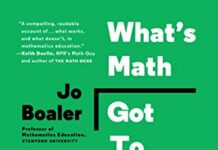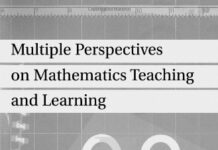
Ebook Info
- Published: 2002
- Number of pages: 224 pages
- Format: PDF
- File Size: 11.67 MB
- Authors: Jo Boaler
Description
NORTH AMERICAN RIGHTS ONLY: This is a revised edition of Experiencing School Mathematics first published in 1997 by Open University Press, © Jo Boaler. This revised edition is for sale in North America only.The first book to provide direct evidence for the effectiveness of traditional and reform-oriented teaching methods, Experiencing School Mathematics reports on careful and extensive case studies of two schools that taught mathematics in totally different ways. Three hundred students were followed over three years, providing an unusual and important range of data, including observations, interviews, questionnaires, and assessments, to show the ways students’ beliefs and understandings were shaped by the different approaches to mathematics teaching. The interviews that are reproduced in the book give compelling insights into what it meant to be a student in the classrooms of the two schools. Questions are raised about and new evidence is provided for: * the ways in which “traditional” and “reform oriented” mathematics teaching approaches can impact student attitude, beliefs, and achievement; *the effectiveness of different teaching methods in preparing students for the demands of the “real world” and the 21st century; *the impact of tracking and heterogeneous ability grouping; and *gender and teaching styles–the potential of different teaching approaches for the attainment of equity. The book draws some radical new conclusions about the ways that traditional teaching methods lead to limited forms of knowledge that are ineffective in non-school settings. This edition has been revised for the North American market to show the relevance of the study results in light of the U.S. reform movement, the “math wars” and debates about teachers, assessment, and tracking. The details of the study have been rewritten for an American audience and the results are compared with research conducted in the U.S. This is an important volume for mathematics teachers and researchers, education policymakers, and for students in mathematics education courses. NOTE: This is a revised edition of Experiencing School Mathematics first published in 1997 by Open University Press, © Jo Boaler. This revised edition is for sale in North America only.
User’s Reviews
Editorial Reviews: Review “Questions are raised about, and new evidence is provided for: the ways in which ‘traditional’ and ‘reform oriented’ mathematics teaching approaches can impact student attitudes, beliefs, and achievements, and the effectiveness of different teaching methods in preparing students for the demands of the ‘real world’ and the 21st century; the impact of tracking and heterogenous ability grouping; gender and teaching styles–the potential of different teaching approaches for the attainment of equity. The book draws some radical new conclusions about the ways that traditional teaching methods lead to limited forms of knowledge that are ineffective in nonschool settings.”―Zentralblatt fur Didaktik der Mathematik”Through her comprehensive, penetrating study of the mathematics departments in two English schools, Jo Boaler shows how mathematics teaching and learning are shaped by teachers and by the settings in which they work. For Americans wondering about the direction that mathematics is taking in their schools, this remarkable book affords profound insights and compelling conclusions.”―Jeremy KilpatrickUniversity of Georgia”It holds a lot of information for anyone who is into research dealing with constructivist and nonconstructivist thinking and teaching. There are also some strong clues into how students perceive the mathematics they are asked to learn and a plethora of other interesting research topics and discussion areas in mathematics education.””The past decade has seen a resurgence in debates about approaches to teaching mathematics, and concerns about persistent inequities in students’ opportunities to learn and learning. Too rarely, however, are these debates grounded in systematic investigation of the enactment of these approaches in real classrooms and their impact on students’ learning….Boaler’s compelling study provides a vivid portrait of contrasts in students’ opportunities to learn in two dramatically different approaches to the curriculum and teaching of mathematics, supplying much-needed evidence about the teaching and learning of mathematics.”―Deborah Loewenberg BallUniversity of Michigan
Reviews from Amazon users which were colected at the time this book was published on the website:
⭐The book decribes a study of the learning in two different schools in England, both from similar working class socioeconomic groups. One school teaches mathematics in a traditional manner and the other uses a progressive approach.In the progressive school, students of mixed abilities are taught in the same class. The major source of learning is based on open ended projects. Although each student is required to turn in an individual project, the students are free to work together. The atmosphere at first glance appears chaotic. The noise level is somewhat high due to all the chatter. Many students may be talking about topics unrelated to their assignment. Any adults entering the class, whether an official visitor or the principal, are routinely ignored.By all measures the students in the progressive school learn more. They do better on standardized tests and on special tests of the author’s creation. They enjoy math more and have a better understanding of what math is about. They perceive a connection between the math they learn in school and real world problems, while the students in the traditional school fail to see the connection.All of this suggests the superiority of progressive teaching. Before reading the book I was already disposed to believing this, so it takes some effort to step back and question just what was shown. Although the book goes into great detail describing the testing methodology it is not clear just what was taught in the two schools. How much beyond arithmetic did the schools go? There is an indication that students were taught how to plug numbers into formulas. How much were they taught about formulating word problems into algebraic form and then solving them? The book goes on at length about one of the projects in the progressive school. What other types of projects were there? Did any of them involve algebra?In the back of my mind the whole time I was reading the book was the nagging question of why progressive education has not caught on, particularly since the progressive school in this case seems to be so much superior. This leads to further questions. Since the two schools have been in operation for a while it seems worth asking what becomes of graduates of the schools. Is there any significant difference in terms of students who go on to higher education or in income levels? Are there any other differences?To me the most important aspect of the progessive education is that more students enjoyed math and understood the creative aspect of mathematics. Others may not feel the same way. They may be put off by the apparent disorder in the progressive classrooms. They will need strong evidence that the progressive approach has an improved lasting impact. Until that can be shown I do not think that progressive education will catch on.
⭐
Keywords
Free Download Experiencing School Mathematics: Traditional and Reform Approaches To Teaching and Their Impact on Student Learning, Revised and Expanded Edition (Studies in Mathematical Thinking and Learning Series) 1st Edition in PDF format
Experiencing School Mathematics: Traditional and Reform Approaches To Teaching and Their Impact on Student Learning, Revised and Expanded Edition (Studies in Mathematical Thinking and Learning Series) 1st Edition PDF Free Download
Download Experiencing School Mathematics: Traditional and Reform Approaches To Teaching and Their Impact on Student Learning, Revised and Expanded Edition (Studies in Mathematical Thinking and Learning Series) 1st Edition 2002 PDF Free
Experiencing School Mathematics: Traditional and Reform Approaches To Teaching and Their Impact on Student Learning, Revised and Expanded Edition (Studies in Mathematical Thinking and Learning Series) 1st Edition 2002 PDF Free Download
Download Experiencing School Mathematics: Traditional and Reform Approaches To Teaching and Their Impact on Student Learning, Revised and Expanded Edition (Studies in Mathematical Thinking and Learning Series) 1st Edition PDF
Free Download Ebook Experiencing School Mathematics: Traditional and Reform Approaches To Teaching and Their Impact on Student Learning, Revised and Expanded Edition (Studies in Mathematical Thinking and Learning Series) 1st Edition


